How to Troubleshoot Most Central AC Problems
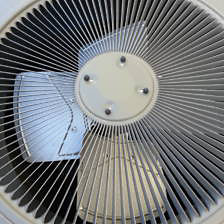
We see it all the time: A frustrated homeowner calls us to fix an AC problem—a problem they could easily have fixed themselves!
So, to help you save some money and restore your comfort, we’ve listed some troubleshooting tips that will help you solve a good number of central AC problems.
Try the following DIY AC troubleshooting tips the next time you’re having AC issues:
- Check for a dirty air filter
- Check your thermostat settings
- Check your air conditioner circuit breakers
- Check your outdoor unit
- Check all air vents
We’ll show you specifically what to do and explain the specific AC problems you can solve by checking the items above.
Check for a dirty air filter
AC problems caused by a dirty filter:
- Low airflow from air vents
- Ice on refrigerant lines
- Frozen evaporator coil
- Water leaking from your AC
- Inadequate cooling (hot/cold spots, AC struggles to reach set temperature)
- Higher-than-normal energy bills
- Equipment failure
What to do: Take a look at your air filter. Replace your filter if it’s dirty or clogged (like the filter to the right).
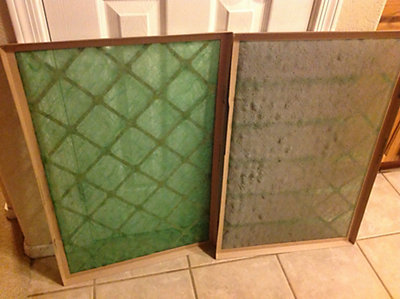
You see, a dirty filter “suffocates” your AC unit. You see that layer of dirt on the filter? That dirt limits the amount of air your AC unit can breathe in.
And when your AC isn’t getting enough airflow into the system, it causes a whole host of AC problems and can eventually lead to complete system failure.
Check your thermostat settings
AC problems caused by wrong thermostat settings:
- Warm or hot air coming from air vents
- AC won’t turn on
What to do: Go to your thermostat and check to make sure it’s set to COOL not HEAT.
We’ve made many service calls to repair an AC that “isn’t working” just to find that they had forgotten to move the thermostat from HEAT to COOL. It happens a lot, especially when we switch from heating to cooling season.
Check your air conditioner circuit breakers
AC problems caused by tripped breaker:
AC won’t turn on
What to do: Go to your home’s main electrical panel and check for circuit breakers that aren’t in the ON position. If your circuit breakers are clearly labeled, look specifically for one labeled “air conditioner” or “AC”.
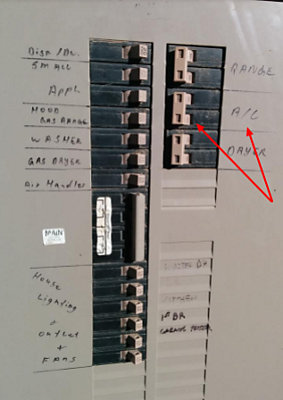
If your AC circuit breakers are tripped, push the breakers firmly into the ON position and try running your AC again.
Note: If the breaker immediately trips once the AC runs, don’t try flipping the circuit breaker again. You’ll need to have a professional look at the unit as this is a sign of a larger electrical problem.
Related: Why Does My Air Conditioner Keep Tripping the Circuit Breaker?
Check your outdoor unit
AC problems caused by a dirty outdoor unit:
- Higher-than-normal energy bills
- Warm air coming from air vents
- AC doesn’t provide adequate cooling
- Frequent repairs
What to do: Go outside and take a look at your outside AC unit (condenser). If you see a layer of dirt on the outside of the unit, use a hose on a gentle setting to remove the dirt.
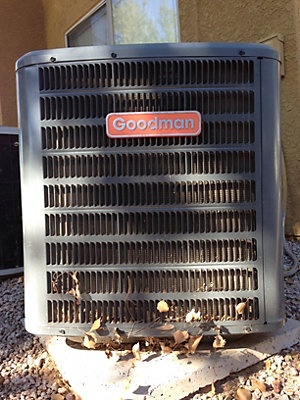
Even leaves or branches stuck in the condenser coils can cause serious AC problems.
Note: Also keep an eye out for foliage or fences that are within 2 feet from your outdoor unit. Move any surrounding objects at least 2 to 3 feet from your condenser.
Check all air vents
AC problems caused by closed/blocked air vents:
- AC struggles to cool your home
- Ice on refrigerant lines
- Frozen evaporator coil
- Water leaking from your AC
- Damaged compressor
- Blower motor problems
- Increased duct leakage (higher AC bills)
What to do: Walk throughout your home and make sure that all supply vents (both return and supply) are open and unblocked—even the ones in unused rooms.
Rugs, drapes or furniture can easily block both return vents (vents that suck air in, see picture below) and supply vents (vents that blow air out) so keep an eye out for blocked air vents throughout your home.
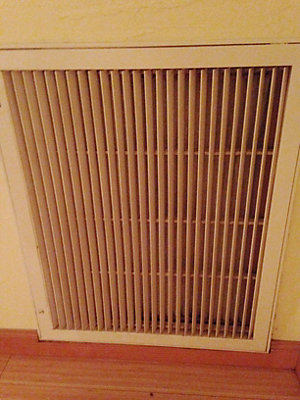
AC return vent.
Many homeowners also purposefully close supply vents in rooms that aren’t being used because they think they will save money on energy bills. But really, all that does is increase energy bills and cause other AC and ductwork problems.
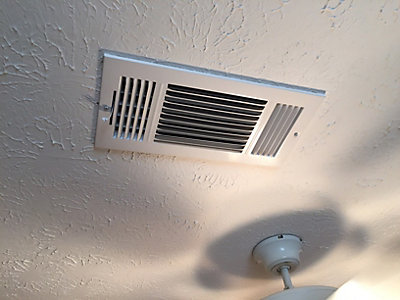
AC supply vent.
Related: Should My AC Vents Be Open or Closed?
Call an AC Repair Expert in Denver
If you're having issues of any kind with your air conditioning system and you're in the Denver area, give Plumbline a call. We have been repairing air conditioners since 1998 and serve communities in the Denver metro area and Northern Colorado as far north as Fort Collins and south as Castle Rock.
Related Reading:
Need help from a Colorado Plumbing, Heating, Cooling, or Electrical Specialist?
For your convenience, you can request an appointment in one of two ways:
- Call us at (303) 436-2525 for immediate assistance.
- Click on the button below to schedule your appointment online.
Related Reading
Join Our Email Newsletter
Receive updates, current news, promotions, and industry tips.
